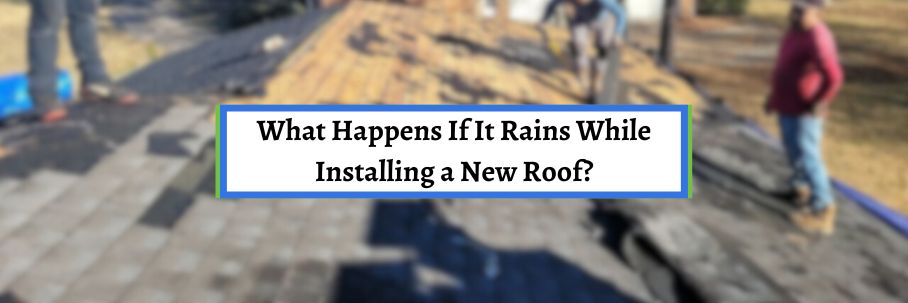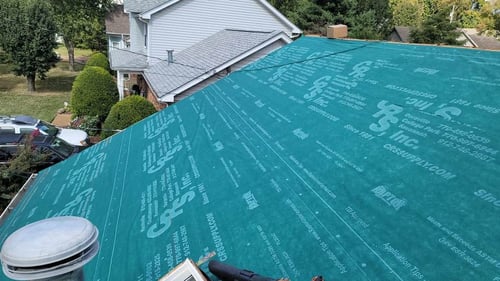What Happens If It Rains While Installing a New Roof?

Your roof is your home’s first line of defense against rain and other elements. Unfortunately, getting a new roof requires opening up your home and making it vulnerable if it starts raining.
So, what happens if it rains when your new roof is getting installed? How does a roofing contractor handle it?
For over 30 years, the team at Bill Ragan Roofing has helped homeowners prepare everything getting a new roof could throw at them. That’s why I’ll break down what you can expect if you run into rain or other inclement weather when installing your new roof.
This article answers the following questions:
- Can roofers install a roof when it’s raining?
- What happens if it starts raining while installing your new roof?
- How should a roofer prepare for rain during the roof replacement process?
Can roofers install a roof when it’s raining?
No, a roofer cannot (correctly) and should not install a roof when it’s raining. Whether there’s rain in the forecast or a pop-up shower, no roofing work should be done when the roof is wet.
But trust me, not working in the rain is beneficial to both your roof and those working.
Installing a new roof in the rain can be very costly
After the tear-off process of your roof replacement, your roof’s decking is left exposed, leaving your roof “open”. If it starts raining while your roof is open, it can cause significant water damage to your home’s interior.
Water will go everywhere in your home if the rain is heavy enough, which leads to damaging your valuables, flooring, drywall, and anything else in the water's path. Not only do you have to replace things with water damage, but you’ll need a company to come in for a proper cleanup.
All of this gets costly very quickly, and hiring a roofer without insurance could leave you having to go through your insurance or pay out of pocket.
Your roof won’t be installed correctly
While water getting into your home is bad enough, installing a new roof over wet roof decking guarantees installation issues. Leaving wet and saturated decking leads to rotting, which causes mold/mildew growth, the wood to change shape, or the boards to completely lose their load-bearing capacity.
Installing materials on a wet decking also creates a misshapen roof and leads to the shingles not adhering correctly or evenly because they were installed over a damp or slick surface. No matter what, installing a roof in the rain guarantees problems down the road.
It’s not safe to install a new roof in the rain
The two problems above actually impact you and your wallet. However, roofers shouldn’t install a new roof in the rain because it simply isn’t safe.
Roofing on a dry day is already dangerous, and adding rain to the mix significantly multiplies the risk. The last thing you or a reputable roofing company wants is someone falling off your roof, which is why it’s always surprising to see crews working in the rain.
What happens if it starts raining while installing your new roof?
Now you know that roofers shouldn’t install a new roof in the rain. However, there’s always the chance for an unexpected shower to roll in.
If it starts raining in the middle of your roof installation, the crew will tarp the areas of your roof that have exposed decking. This tarping will stay on until it’s safe enough to get back on your roof and begin the installation process again.
Unfortunately, a big problem inexperienced roofers run into is when an entire roof is open, or areas are too big to tarp when rain starts. That’s where “drying in” sections as soon as the old roof is torn off comes into play.
 (Synthetic underlayment installed over decking)
(Synthetic underlayment installed over decking)
Drying in is simply covering the roof decking with underlayment to help protect it before shingle installation begins. This ensures there’s at least a watertight barrier protecting your home until it's dry enough to start working again.
How should a roofer prepare for rain during the roof replacement process?
Protecting your home is a crucial piece of the roof replacement process, and having a prepared plan in the event of rain is a big part of it. You just learned they’ll tarp your roof if it starts raining, so obviously, all roofers should be prepared with tarps already on-site.
However, every roofing contractor should also check the weather on the day of a roof replacement to determine if it’s safe to open your roof. My rule of thumb is not to open up a roof if there’s a 40% chance of rain on the day it’s supposed to be installed.
This doesn’t mean it can’t be done if there’s a greater chance of rain, especially if they have a game plan and a way to execute it. I just like to be safe if the conditions look like they could give us a problem.
What does the entire roof replacement process look like?
If your roofer is prepared and paying attention, you’ll be protected if it starts raining when your new roof is installed. And as long as you hire a reputable roofing company, you won’t have to worry if there’s rain in the forecast because a plan will be in place.
The only thing you have to worry about is the increase in the time it takes to complete your roof replacement because of the weather. Unfortunately, the actual roof replacement process also causes undue stress if you don’t know what to expect.
This is especially true once the chaos begins and debris starts flying around. That’s why I wrote another article breaking down the entire roof replacement process from start to finish.
Check out the 8-Step Process to Replace Your Roof to help you understand what happens on the day your new roof is installed.


